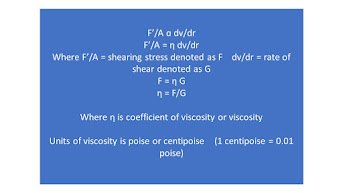Rheology/ Newtonian system l Study Pharma l
Rheology:
Rheology is made of two words that taken from Greek words one is "Rheo" and other is "Logos"
"Rheo" means to flow, and "Logos" means science.
"Rheo" means to flow, and "Logos" means science.
Rheology term is defined as the science that deal with the study of flow property of that substance.
Rheology principle is applied in to study pharmaceutical preparations like cream, ointment, toothpaste, emulsion, suspension and other aspect like to study inks, paints, road-building materials, dairy products, etc.
Rheology involved in mixing, flow of material, for their packaging into containers, and their removal from bottle, passing through syringe needles. And also involve in the selection of equipment.
Appropriate equipment selection leads to give desirable product or Inappropriate equipment selection leads to give undesirable products.
Viscosity:
Viscosity is defined as the property of the substance that resist own its flow.
Viscosity is directly proportional to resistance of the substance.
Rheology is divided into two categories:-
1. Newtonian system 2. Non-Newtonian system
1. Newtonian system:
Newtonian System is defined as the flow property of the substance is accordance to "Newton's law of flow".
Consider a deck of cards placed at particular point, top of the card free from any type of surface contact whereas bottom of the card come in contact with base surface. When we applying a force on the top then top layer of card move very fast and cover some distance as compared to bottom layer of card due to contact points that leads friction between the bottom layer of card and base surface. As similar in sea water.
Conclusion:
Viscosity in depth is high as compared to top due to friction arises from contact.
Equation for Viscosity:
- Applied force on particular surface area F'/A, that is shearing stress.
- After this, cards move with velocity (dv) to cover distance (dr) is velocity dv/dr that is rate of shear.
Shearing stress is directly proportional to rate of shear.
Units for Viscosity:
Kinematic viscosity:
Kinematic viscosity is defined as the viscosity is divide by density of that test liquid.
Units for Kinematic viscosity is:
Stoke or Centistoke
Temperature Modifying Viscosity or affecting viscosity:
As temperature start raising, viscosity of the liquid start decreasing that represent fluidity of the liquid ( reciprocal of viscosity).
Temperature affecting viscosity of liquid is determined by the equation given by Arrhenius equation of chemical kinetics:
How?
When temperature increases, liquid molecules that tightly bonded with each other as a cohesive force become rich in energy. Then liquid molecules start moving by breaking bonds which result there is vacant space or hole formed. Other molecule occupying the vacant space or hole to fulfill but a new hole is formed where molecule placed and then occupied front hole to fulfill. And this new hole occupies by other molecule and again hole formed, this process continue and the system becomes to flow. This is known as fluidity of liquid.
Non-Newtonian System is defined as the flow property of the substance is not accordance to "Newton's law of flow".
2. Non-Newtonian systems:
Newtonian System is defined as the flow property of the substance is not accordance to "Newton's law of flow".
Non-Newtonian systems are of three types:
* Simple plastic system
* Simple pseudoplastic system or pseudoplastic system
* Dilatant system
* Simple plastic system:
Simple plastic system is a non-newtonian system that is known as shear thinning system and also known as Bingham bodies.
In this, curve don't pass through origin just intercept the shear stress axis at a particular point that is known as yield point (Yield point is determine the degree of flocculation).
Bingham bodies are those bodies that exhibits plastic flow. Bingham body does not start flow until the shear stress corresponds to the yield point or value is exceeded. In other word, when shear stress is not increases beyond the yield point body shows elastic nature or if it is exceeded beyond the yield point then body start flow.
Plastic viscosity is determined by the given equation:
* Simple pseudoplastic system:
Simple pseudoplastic system is a non-newtonian system that is known as shear thinning system.
In this, curve passes through origin. Pseudoplastic system made up of natural and synthetic gums like methylcellulose, cellulose, sodium carboxy methylcellulose, tragacanth, etc.
In this polymeric chain that tangled and have lots of contact points which results in resist to flow the system. Applying the shear stress (force) polymeric chain that tangled aligned in manner so that contact points between molecules broken and system start flow.
* Dilatant system:
Dilatant system is a non-newtonian system that is known as shear thickening system.
In this, thickening of the system increase on the application of shear stress.
Before the application of shear stress:
Molecules of the system occupies minimum void spaces, closely packed and the amount of solvent in the system is sufficient to become lubricate or make the system to flow.
On the application of shear stress:
Applying the shear stress, closely packed molecules in the system start expand and form open packed structure, larger void spaces and the sufficient amount of solvent fill inside the void spaces. Thus molecules are not longer lubricated or they show resistance to flow.





Comments
Post a Comment